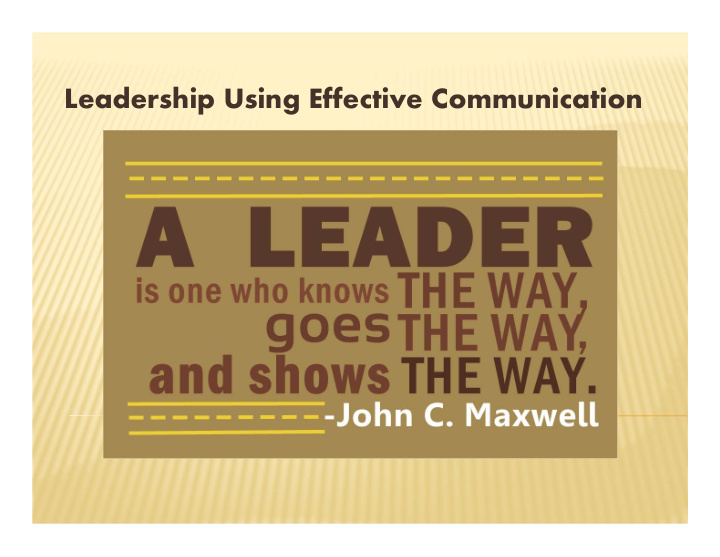



Leadership Using Effective Communication
L eader eadership ship = = Using communication t Using communication to achie achieve desired outco e desired outcomes. es.
Wh Why is communication y is communication central t central to leader leadership? ship? Because ef Because effectiv ctive leader e leaders w s work with and thr with and through o ugh others. hers.
Communication is cir Communication is circular ular, no , not linear t linear. Inst . Instead... ead... Communication is a transactional pr Communication is a transactional process ocess thr through which messages are simultaneously ugh which messages are simultaneously sent and receiv sent and received. ed.
Communication has bo Communication has both th verbal and non-v rbal and non-verbal dimensions. rbal dimensions.
Communication style is tied t Communication style is tied to leader leadership type. ship type. Types of Leader pes of Leaders: s: • Authoritarian thoritarian • Democratic Democratic • Laissez-F Laissez-Faire ire
Which leader Which leadership style is best depends upon: ship style is best depends upon: an organization’s an organization’s purpose, purpose, • the conditions in the conditions in which it operat which it operates, es, • the com the composition of its members. osition of its members. •
Authoritarian Leadership T thoritarian Leadership Traits: aits: Unilat Unilaterally sets goals, erally sets goals, • policies, pr policies, procedures ocedures Top do p down communication wn communication • Contr Controls discussion ls discussion • Rewards obedience and s obedience and • punishes mistak punishes mistakes es
Democratic Leader Democratic Leadership T ship Traits aits : : Follo llower ers in s involv lved in ed in setting goals, policies, and setting goals, policies, and • pr procedures ocedures Two-w o-way, open communication open communication • Facilitat cilitates discussion s discussion • Rewards good w s good work, resor rk, resorts t ts to punishment punishment • as last resor as last resort t
Laissez-F Laissez-Faire Leader ire Leadership T ship Traits aits : : Follo llowers enjo ers enjoy free rein y free rein • Noncommittal communication Noncommittal communication • Avoids directing discu oids directing discussion sion • Of Offers f rs few if an w if any re y rewards or s or • punishments punishments
Pr Pros and Cons of A os and Cons of Authoritarian thoritarian Leader eadership hip Pr Pros os • High ef High efficiency ciency • Quick and appr Quick and appropriat opriate solutions e solutions if leader is kno if leader is knowledgeable ledgeable Cons Cons • Creat Creates conditions f s conditions for discont r discontent ent • Discour Discourages inno ges innovation ation • Increases turno Increases turnover and absent er and absenteeism eeism • Fost sters cultur ers culture of dependency e of dependency
Pr Pros and Cons of Democratic Leader os and Cons of Democratic Leadership ship Cons Cons • Decision-making can be slo Decision-making can be slow and cont and contentious entious • Majori Majority ma ty may be wr y be wrong ong • Minority might f Minority might feel possible resentment eel possible resentment Pr Pros os • Encour Encourages ages inno innovati ation with on within in accept accepted parame ed parameters rs • Decreases turno Decreases turnover and absent er and absenteeism eeism • Increases par Increases participation b icipation by f fost stering sense of buy ering sense of buy-in in
Pr Pros and Cons of Laissez-F os and Cons of Laissez-Faire Leader ire Leadership ship Cons Cons • Dif Diffused decision-making fused decision-making • Lack of clear direction Lack of clear direction • Potential chaos ntial chaos Pr Pros os • High inno High innovation if org’l ation if org’l members are embers are kno knowledgeable and motiv ledgeable and motivated • Increases pr Increases productivity and satisf oductivity and satisfaction f action for r highly motiv highly motivated e d exper perts s
Leader Leadership ship ≠ A Authority uthority
Managing Managing ve versus Leadership Leadership (e (exercise) ise)
Follo llowers Canno Cannot ha t have leader leaders without f s without follo llower ers. s. Leaders and follo Leaders and f llowers are relational par ers are relational partners who pla ners who play com complementar lementary r y roles in les in working t ing toward achie achieving goals. ing goals.
Treat p people a as i if t they w were w what t they o ought t to b be a and yo you ma may help y help them become what the them become what they are capable of being. are capable of being. — Johan W Johan Wolfgang v lfgang von Goe n Goethe he
There are tw There are two primar o primary f y forms of rms of communication be communication betw tween leader een leaders and f s and follo llowers: Task (repor sk (report talk) t talk) Relational (rappor lational (rapport talk) talk)
Theor Theory X X Theor Theory Y Y
A A word about the challenges t about the challenges to leaders posed b leaders posed by millennials. millennials. Three k Three key traits: y traits: Demanding politically correctness Demanding politically correctness Privileging of per Privileging of personal opinions onal opinions Cra Craving positiv ing positive f feedback eedback
Ef Effectiv ctive Communication: e Communication: • Ethos Ethos • Logos Logos • Pathos thos
Ethos = credibility
Logos = logic
Pathos = emotional appeal
Com Compliance gaining communication liance gaining communication
P owe ower l language
T he he E nd nd
Recommend
More recommend